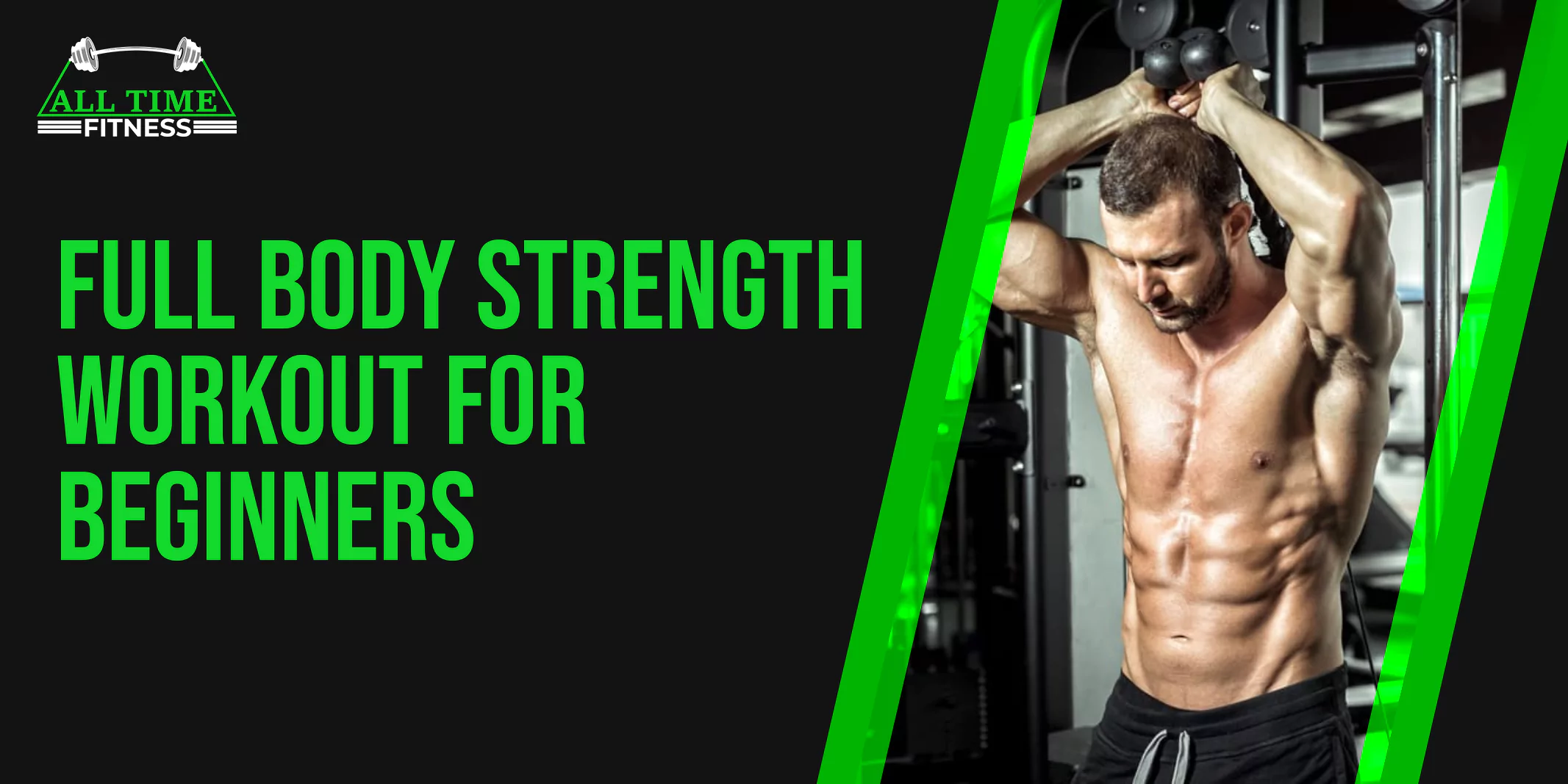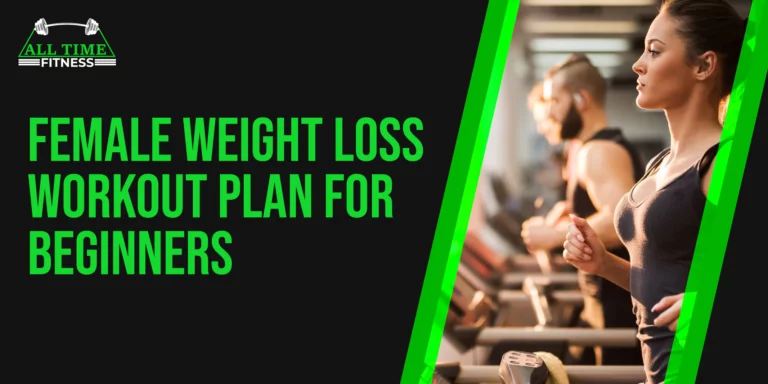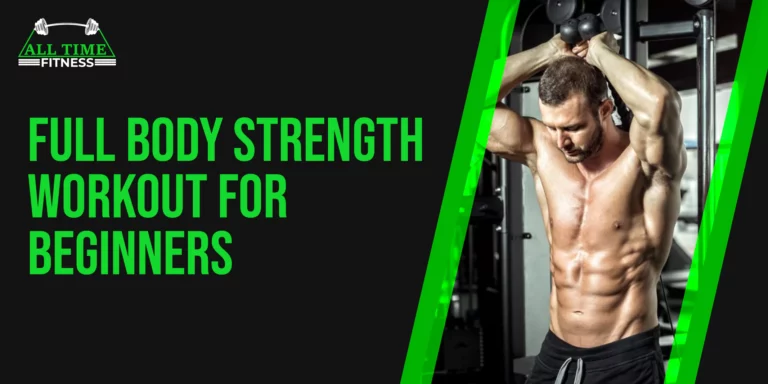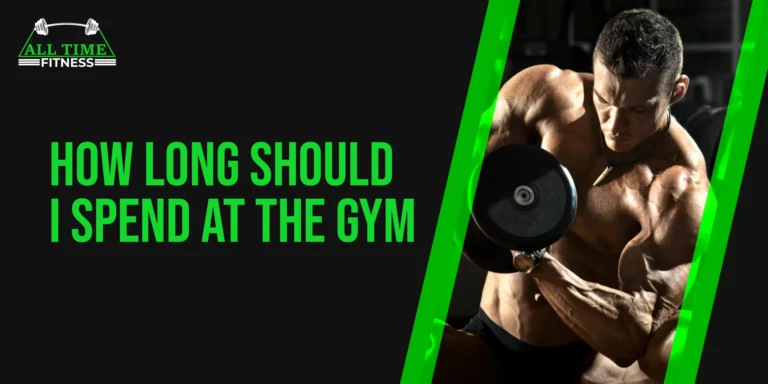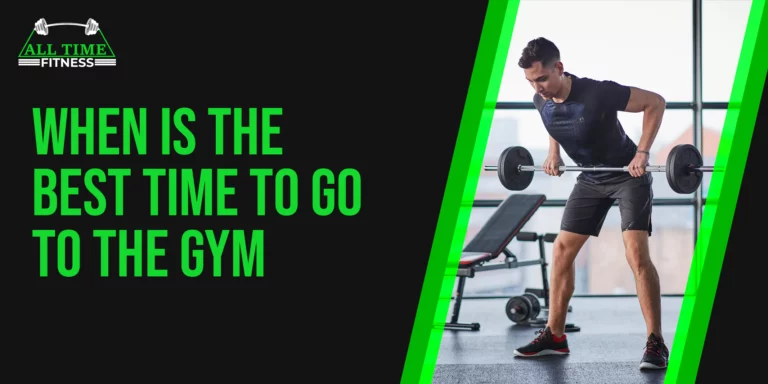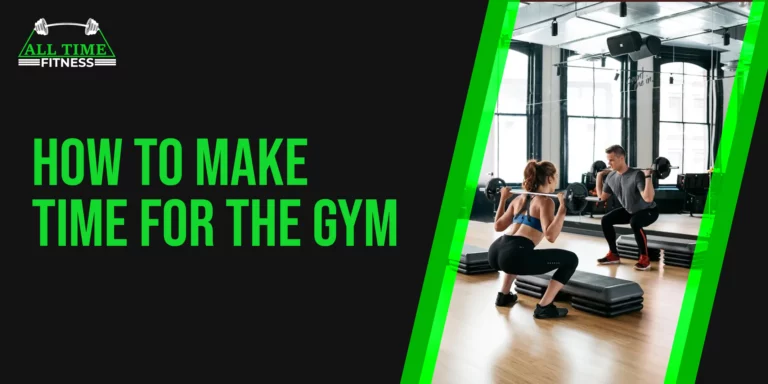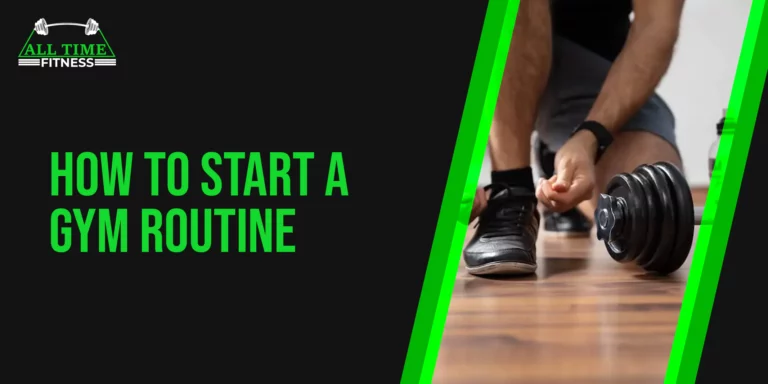Strength training is one of the most common terms you’ll come across in your fitness journey. And rightfully so!
It targets your muscles, helps you lose weight, strengthens your bones, and improves overall body coordination and balance.
According to the Mayo Clinic, regular strength training and aerobic exercise may help improve thinking and learning skills for older adults.
Therefore, expert trainers recommend a full body strength workout for beginners because it targets all major muscle groups in one session, it’s efficient and time-saving.
In this article, we’ll explore the ideal full body workout routine for beginners and discuss why it’s important to perform a whole-body workout for beginners.
Stay strong!
But staying strong also means staying safe.
Safety and Precautions
Before starting a beginner full body strength workout, it’s important to be safe than sorry. Therefore, consult with a healthcare professional before starting any new workout to ensure everything works for you.
The second important thing is to listen to your body. If any exercise is causing discomfort or pain, stop immediately and try the alternatives. For example, if you have knee pain, high-impact exercises can be painful to you. Instead, you can try low-impact exercises that are less stressful to your knees. Also, wear proper workout shoes and attire that provide support and comfort.
Above all, a proper warm-up and cool-down session is an important part of your workout routine for injury prevention and enhanced performance. Also, it reduces post-workout aches and stiffness of your body.
Warm-Up Routine
Professional trainers recommend starting with a 10 to 15-minute warm-up session to increase the body temperature and help increase blood flow to the muscles. For beginners, a proper warm-up session may prevent injury and post-workout discomfort.
You can start with slow jogging, jumping jacks, or brisk walking as an active warm-up session. You can also try cardio machines, such as a treadmill.
Note: Don’t forget to incorporate dynamic stretches, such as arm circles and leg swings to get your muscles moving.
Strength-training gym workout for beginners
If you’re a beginner, trying to navigate your workout sessions, fret not! We have compiled an easy full body workout for beginners you can try at home or the gym near you.
Note: You can modify or swap in an exercise if it doesn’t suit you. Just listen to your body and do what feels right. No hard and fast rules…
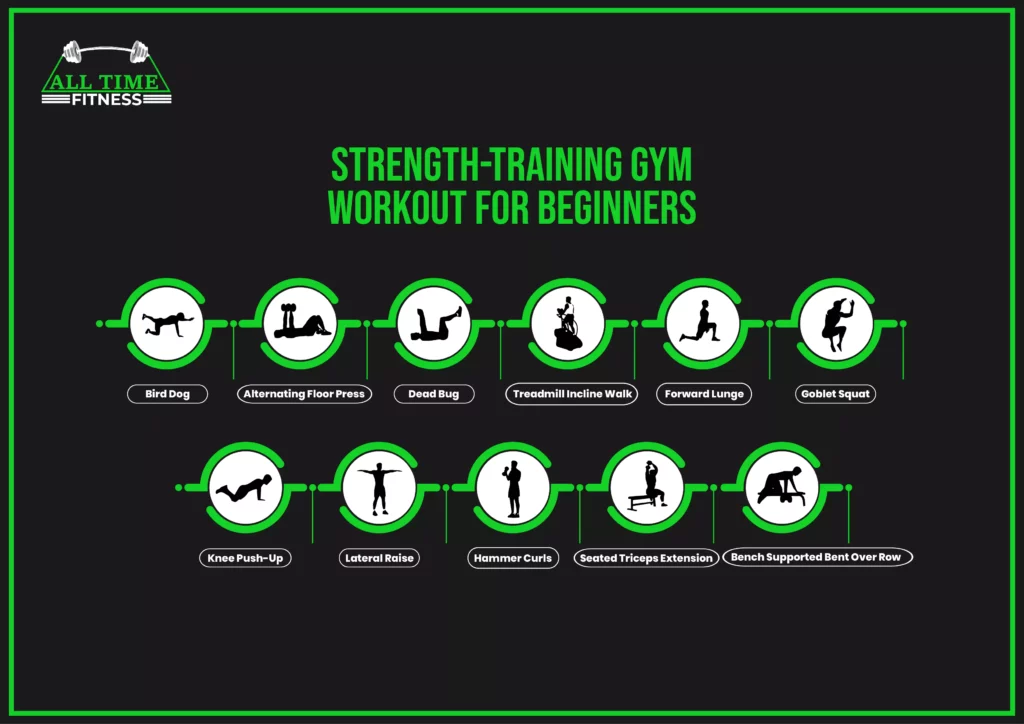
Bird Dog
The bird dog is an excellent full-body strength workout for beginners that strengthens your core and improves stability, coordination, and balance.
Here’s how to do it:
- Begin on all fours and keep your knees hip-width apart.
- Keep your hands shoulder-width apart and under your shoulders.
- Pull your belly button in towards your spine and engage your core.
- Keep your spine neutral, and back flat, and avoid arching or sagging.
- Now, extend one arm straight out in front of you and keep it parallel to the floor.
- Similarly, extend your opposite leg, keeping it straight behind you. (your toes should point out and your heel should reach the wall behind you)
- Hold this position for a few seconds. Keep your back flat and core engaged.
- Repeat the movement on the other side.
Note: Repeat 3 sets of 10-12 reps per side. However, stop if you feel any pain or discomfort.
Alternating Floor Press
To master the alternating floor press, choose a challenging but manageable weight that helps you maintain proper form throughout all repetitions.
Since this exercise is standing for building strength in your chest, shoulders, and triceps, you should feel comfortable lifting weights.
Here’s how to do it:
- Lie on your back and keep your knees bent; feet flat on the ground.
- Hold dumbbells in each hand. Keep your palms facing forward.
- Keep the dumbbells above your shoulders and slightly bend your arms.
- Press one dumbbell towards the ceiling and extend your arm fully. (Your core should be engaged and there should be a slight arch in your lower back)
- Pressing one arm up, lower the other dumbbell down towards your chest. (The dumbbell should not touch your chest completely)
- Continue switching sides and aim for 3 sets of 10-12 reps per arm.
Note: If you haven’t lifted weight before, please consult a certified trainer to learn proper form and technique.
A Video Guide For Dumbbell Floor Press
Dead Bug
Dead Bug is one of the best full-body strength exercises that can be performed with your body weight with no additional equipment.
If you have back pain, Dead Bug is an excellent core-strengthening exercise that targets your deep abdominal muscles.
Since it’s a complex workout, targeting big muscle groups, it is recommended to perform it under expert supervision to avoid injuries.
Here’s how to do it:
- Lie down on your back on a yoga mat and keep your knees bent
- Lift both legs keeping hips and knees bent at 90 degrees (think a tabletop position)
- Raise your arms, pointing straight towards the ceiling
- Maintain a natural posture, and extend your right leg forward.
- Keeping the right leg forward, raise your left arm overhead
- Bring your arm and leg to their original position
- Repeat the same exercise on the opposite side
- Do 1 to 3 sets of 5 to 12 reps each side
Note: Forget about hunching! Throughout this exercise, Keep your spine in a supported position.
And don’t forget to breathe! If you feel any pain, take a break and listen to your body.
Treadmill Incline Walk
Do you find treadmill workouts boring? Here’s to adding variety and keeping things exciting.
The treadmill incline walk is a great whole-body workout for beginners that burns more calories helps you lose weight, improves cardiovascular health, and provides oxygen and nutrients to your muscles.
The best of all? It improves your everyday stamina.
Not sure how to start? Here’s an easy 10-minute beginner-friendly incline treadmill workout for you:
- Warm-up: 3 minutes
- Speed: 5kph
- Incline: 0%
- Workout: 10 minutes
- Speed: 5kph
- Incline: 5%
- Cooldown: 3 minutes
- Speed: 4kph
- Incline: 0%
Note: Incline treadmill workouts are easy and simple. However, if you haven’t used a treadmill before, we recommend adjusting the speed and incline to match your fitness levels. Also, keep initial incline workouts to 10 minutes and increase gradually.
Forward Lunge
Forward lunge is a great beginner-friendly exercise that builds your glutes, quads, hamstrings, and calves. However, there are a few factors you should consider before moving forward with forward lunges.
- If you want to build muscle fibers with every rep, move slowly.
- If you want to increase your heart rate, move as fast as you can, maintaining a correct form and posture.
Here’s how to do forward lunges:
- Stand tall and nice and keep your feet hip-width apart with relaxed arms at your sides.
- Squeeze your belly as tight as you can to engage your core.
- Take a big step forward with one leg and bend both your knees while you lower yourself down. Aim for the right angle at each knee.
- Keeping most of your weight on your front leg, use your back leg for balance.
- Keep your chest tight, nice, and tall. When you’re ready to come back up, press down through your front foot to push yourself back to standing tall.
- Now switch sides. Repeat everything with the opposite leg. Easy peasy!
- Do 2 to 3 sets of 10 to 15 reps on each side
Note: If you’re a beginner, start slowly and continue moving slowly until you gain balance and control.
Goblet Squat
Like most squatting movements, the goblet squat works on your glutes, quads, hamstrings, calves, core (abdominals and spinal erectors), forearms, biceps, and shoulders.
Besides, goblet squats help improve your form and work on major lower body muscles along with your core, back, forearms, and shoulders. In short, an excellent form of exercise for beginners.
Here’s how you can ace goblet squats.
- Stand with your feet a little wider than your hips. (Picture your toes pointed slightly outwards)
- Hold weight right in front of your chest and bend your elbows
- Suck in the air and squeeze your belly button tightly. Look ahead straight and keep your back in a nice, straight position
- Take a deep breath and bend your knees while pushing your hips back.
- In a squatting position, keep the weight close to your body, making sure your chest is firm and puffed out. The target is to get your hips lower than your knees.
- Avoid tipping up on your toes and keep your feet firmly on the ground
- Make sure your elbows touch the inside of your knees at the bottom. This is to keep them straight
- Now, push through your heels and straighten up your legs as you stand up. Breathe out and squeeze your glutes at the top.
- Repeat the squats for as many sets as you feel comfortable with
- Do 3 to 5 sets of 10 to 20 reps on each side
Note: Avoid holding the weights too far from your body. Ensure your elbows are bent fully and the weights are closer to your chest.
Knee Push-Up
One of the simplest full body beginner workouts is knee push-ups. Especially if you cannot do traditional push-ups, you should try knee push-ups.
Also, if you’re recovering from upper back or shoulder issues, knee push-ups are more beneficial for you than the traditional ones.
Here’s how to do it:
- Get comfortable on a yoga mat and kneel on the floor
- Put your hands out, right in front of you shoulder-width apart
- Squeeze in your tummy to keep your back straight
- Bend your elbows and lower your chest towards the floor slowly
- Now, push back up to your starting position while straightening your arms slowly. Don’t rush this process
- Repeat as many as you can and don’t forget to take a break in between
- Do 2 to 3 sets of 12 to 20 reps on each side
Note: Always take a break if you notice a slight change in your form. Start slowly and soon you’ll build up strength over time.
Lateral Raise
Lateral raise is one of the best beginner-friendly full body strength exercises that target the lateral head of the deltoid muscles for a defined shoulder appearance. They also help develop a more sculpted and toned shoulder look.
The best of all? They are an easy full-body workout that requires minimal equipment (just dumbbells) and simple abduction movement.
Here’s how to do it:
- Based on your fitness level, take a dumbbell in each hand and hold it down by your sides, palms facing your body.
- Stand tall with your feet hip-width apart. Shoulders relaxed back, core tight, and eyes looking straight.
- Raise your arms to the sides and hold for a second
- Keeping your arms straight, raise them to the sides. Keep your elbows at shoulder level. Inhale as you lift your weights
- Hold your breath and squeeze your shoulders for a few seconds
- Lower the weights down to your sides gradually. Exhale as you lower the weights
- Aim for 3 to 5 sets of 2 to 6 reps
Note: Avoid using too many weights altogether. Start slow and steady. Also, avoid dropping your head forward and maintain a good posture with a straight neck and spine alignment.
Hammer Curls
If you want to increase your bicep size, improve your grip, and maintain wrist stability, hammer curls are your answer!
They are super common among powerlifters and strongman athletes to strengthen their muscles. However, many beginners, like you, love this exercise for how easy it is (under the right supervision!)
Here’s how to do it:
- Grab dumbbells in each hand (weights do not matter!) Hold them by your sides, palms facing forward
- Stand tall and squeeze your shoulder blades together for improved posture
- Hold the dumbbells straight down
- Bend your elbows and slowly lift the weights up towards your shoulders. Make sure your wrists are straight.
- Just when the weights reach your chest, flex your arms and hold for a second. Make sure your palms are facing up at the top.
- Do 2 to 3 sets of 8 to 15 reps
Note: If you do not have your desired weights, you can use a small towel to help increase the muscle activity of your forearm muscles.
Seated Triceps Extension
Seated tricep extensions target the triceps, the horseshoe-shaped muscle on the back of your upper arm. This exercise works all three sections of the tricep (long head, lateral head, medial head) to help you build strong, toned arms.
Here’s how to do it:
- Sit at the edge of a flat bench and hold the dumbbells in each arm while your palms face you (if you’re a beginner, grab a lighter dumbbell)
- Bend your knees a little and lean forward slowly. Keep your spine straight and head high
- Hold the dumbbell close to your body until your forearms are pointing straight down towards the floor.
- Now, keep your upper arms still and use triceps to push the weight up slowly. Exhale as you straighten your arms.
- Hold this position for a few seconds
- Lower the weights back down slowly. Inhale as you lower them
- Repeat this exercise as much as you can. Don’t forget to take your due break!
- Aim for 2 to 3 sets of 10 to 12 reps each
Note: Avoid swinging the weights or hunching your back to maintain the correct form and posture.
Bench Supported Bent Over Row
The bench-supported bent-over row is an excellent exercise because it not only targets your back but it’s a full-body beginner workout.
It’s a fairly easy exercise, but unfortunately, not many people perform it correctly. In return, this limits their strength and muscle gains.
Here’s a step-by-step guide on how to do it correctly:
- Stand next to a bench with one leg close to it. Bend the knee and place your foot on top of the bench. Just for support!
- Bend your torso forward and reach your other hand out to steady yourself on the end of your bench.
- Squeeze your abs and back muscles to create the strongest core
- Pick the dumbbell with your free hand. Palms should face your body
- Pull the dumbbell up towards your chest. Keep your upper arm close to your side
- Slowly, lower the dumbbell back down until your arm is straight again
- Do this exercise as much as you can. Switch the arms and repeat this exercise on the opposite
Note: Make sure your back is straight. Always focus on using your back muscles to lift the weight. Avoid swinging or hunching.
Why is strength training important – Five reasons
If you’re a beginner, trying to lose weight or gain some muscles, strength training is no joke!
There are several benefits to strength training backed by science and experienced by common people. Here are a few you should definitely NOT miss!
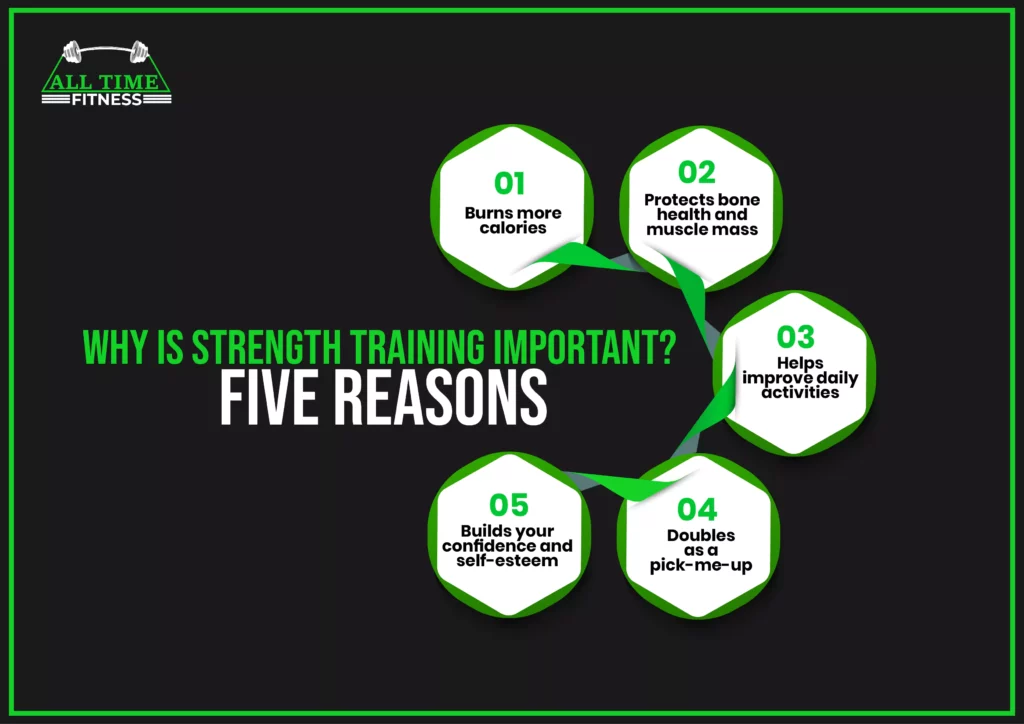
Burns more calories
Strength training doesn’t just boost your metabolism during your workout.
Research suggests a phenomenon known as Excess Post-exercise Oxygen Consumption. According to this, after an intense strength training session, your body enters a heightened metabolic state, burning extra calories for up to 72 hours post-workout!
It’s a mind-blowing concept of strength training where you build muscles and it acts as a constant calorie burner for a more efficient metabolism.
Protects bone health and muscle mass
According to the Journal of Bone and Mineral Research, weight-bearing exercises, including strength training place a temporary stress on your bones that triggers bone-building cells. This stress on bones activates a signaling pathway that promotes the production of new and stronger bone tissues.
Strength training has also been found effective for increased bone mineral density and reduced osteoporosis risk.
Helps improve daily activities
Strength training can improve your daily life activities by boosting your physical and mental well-being.
By increasing muscle strength and endurance, strength training makes everyday tasks easy and less tiring. Especially in older adults, studies have shown a positive correlation between resistance training and improved physical functioning.
Doubles as a pick-me-up
As mentioned earlier, strength training improves physical and mental well-being. It can significantly improve your mood by releasing endorphins (happy hormones) that have stress-reducing properties.
Builds your confidence and self-esteem
The increased muscle mass and strength from the training can help improve your self-esteem and contribute to a more positive outlook on your body image and life, in general.
Now You Know Full Body Strength Workout for Beginners
So, now you know the benefits of a full body strength workout for beginners and how it impacts your mental and physical health in the long run.
The importance of full body strength exercises extends far beyond aesthetics. It helps you overcome stress, boost confidence and self-esteem, build stronger bones and muscles, and whatnot!
This article has also listed some great strength workouts for you to perform safe and effective workouts at home. Whatever you decide to try, always remember two things:
- Consistency is key
- Slow and steady wins the race
You should always start slow and with light weights, but as you progress, don’t shy away from increasing the intensity and difficulty of your workouts to challenge your muscles and maximize the results.
FAQS
Are Full-Body Workouts Good For Beginners?
Yes, full body workouts are excellent for beginners because:
- They are simple and effective
- Build a strong foundation
- Improve daily activities
- Boost metabolism, confidence, and mood
Is 20 Minutes Of Full-Body Strength Training Enough?
Yes, as a beginner, you can see amazing results by investing 20 to 30 minutes into strength training sessions a week. Once your body is in form, you can increase the intensity and difficulty level of your workouts.
How Many Times A Week Should I Do Full Body Strength Training?
It is recommended to do full body strength training at least twice or thrice a week to reap fruitful results.
What Happens If You Do A Full Body Workout Every Day?
Professional trainers do not recommend a full-body workout daily because they can be tiring for your muscles and body. Your muscles need at least 2 to 3 days of recovery time to perform better.

